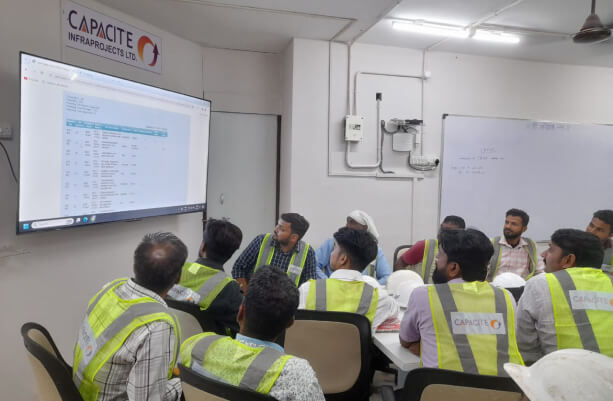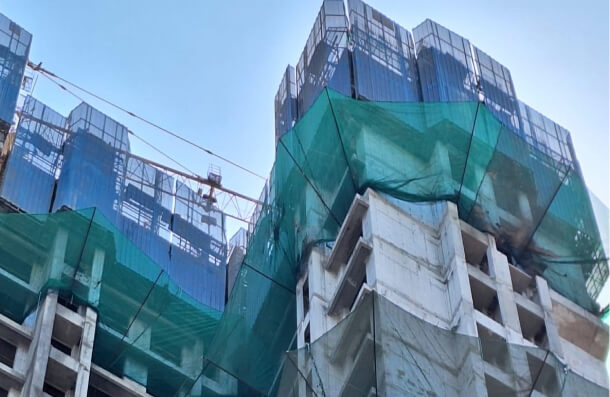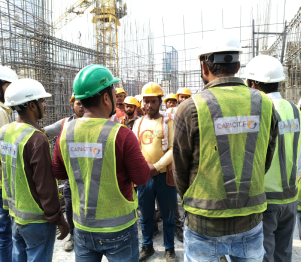
Introduction
In pursuit of excellence and in alignment with our corporate values, Capacit'e Infraprojects Limited has established a robust Health, Safety, and Environment (HSE) system. This report outlines the comprehensive framework implemented by our organization to prioritize the health and well-being of our employees, safeguard the environment, and ensure regulatory compliance across all our projects.
HSE System Overview
The HSE system at Capacit'e Infraprojects Limited encompasses a wide range of initiatives and measures designed to promote a culture of safety and sustainability within our organization. From project entrance security to daily toolbox talks, each component plays a vital role in maintaining high standards of health, safety, and environmental responsibility.

Key Components of the HSE System
- Capacit’e ensures controlled access to project sites through manned security gates equipped with surveillance cameras and access control systems.
- Trained security personnel conduct thorough checks of incoming vehicles, materials, and visitors to prevent unauthorized entry.
- Access passes and identification badges are issued to authorized personnel, contractors, and visitors, with strict enforcement of entry procedures.
- Designated safety parks are established at strategic locations within project sites, equipped with firefighting equipment, first aid kits, emergency contact information, and safety signage.
- Informational displays and posters in multiple languages provide guidance on safety protocols, emergency procedures, hazard identification, and protective equipment usage.
- Safety stations are regularly inspected and replenished to ensure availability and accessibility of safety resources at all times.
- Brightly colored safety posters and signboards are prominently displayed throughout project sites, emphasizing key safety messages and warnings.
- Signage indicates hazard zones, emergency exits, evacuation routes, and safety equipment locations, helping workers navigate the site safely.
- Visual aids incorporate images and symbols for universal understanding, enhancing communication of safety information across diverse workforce demographics.
- Security personnel undergo comprehensive training on access control procedures, visitor management, emergency response protocols, and conflict resolution techniques.
- Training sessions cover topics such as identifying suspicious activities, handling unauthorized entry attempts, and cooperating with law enforcement agencies.
- Regular refresher courses and simulated drills ensure security staff remain vigilant and proficient in their roles.
- Capacit’e organizes safety exhibitions and awareness campaigns at corporate offices and project sites, featuring interactive displays, demonstrations, workshops, and guest speakers.
- Exhibitions showcase innovative safety technologies, best practices, and success stories, inspiring employee engagement and participation.
- Live demonstrations of safety equipment and rescue procedures provide hands-on learning experiences for employees and contractors.
- Capacit’e commemorates National Safety Day and Environment Day with special events, seminars, competitions, and community outreach programs.
- Employee engagement activities include safety pledge ceremonies, tree plantation drives, waste management initiatives, and sustainability workshops.
- Guest lectures by industry experts, regulatory authorities, and environmental activists raise awareness about safety standards, environmental conservation, and corporate social responsibility.
- Toolbox talks are conducted daily before the start of shifts, covering topics relevant to the day’s tasks, potential hazards, safety procedures, and personal protective equipment.
- Trained safety officers facilitate interactive discussions, encourage employee participation, and address questions or concerns raised by workers.
- Tailored training modules are developed for specific job roles, emphasizing practical skills, emergency responses, and regulatory compliance requirements.
- Capacit’e implements a comprehensive fall prevention program, including the installation of guardrails, safety nets, personal fall arrest systems, Wind screens and access platforms at elevated work areas.
- Height safety training is provided to workers engaged in tasks such as scaffolding, roofing, and facade installation, emphasizing proper equipment usage and fall arrest techniques.
- Regular inspections of fall protection systems and periodic safety audits ensure compliance with industry standards and regulatory requirements.
- Project sites are equipped with fire hydrants, extinguishers, hose reels, fire alarms, smoke detectors, and emergency lighting systems as per National Building Code and Fire Safety Regulations.
- Fire safety drills and evacuation exercises are conducted periodically to familiarize employees with emergency procedures and evacuation routes.
- Fire safety awareness campaigns educate employees about common fire hazards, prevention measures, and the importance of early detection and reporting
- Capacit’e convenes regular safety committee meetings comprising representatives from management, frontline workers, and safety professionals to review safety performance, incident reports, and improvement opportunities.
- Employee recognition programs acknowledge individuals and teams for exemplary safety practices, near-miss reporting, and proactive safety suggestions.
- Incentive schemes, rewards, and performance bonuses are tied to safety performance metrics, reinforcing a culture of accountability and continuous improvement.
- Monthly inspections involve comprehensive assessments of workplace conditions, focusing on identifying hazards, ensuring compliance with safety regulations, and maintaining a safe working environment.
- Air quality checks are conducted regularly to monitor indoor and outdoor air, which can affect the health and well-being of workers.
- Results from air quality tests are analyzed to identify potential sources of contamination, implement corrective measures, and improve ventilation systems where necessary.
- Discuss the frequency and methodology of inspections and air quality checks, ensuring alignment with regulatory requirements and industry best practices.
- Seek input on any specific concerns or areas of focus for future inspections and air quality assessments.
- Tailored HSE plans are developed for each project to address unique risks, environmental factors, and regulatory requirements associated with construction activities.
- Project-specific plans outline hazard assessments, mitigation measures, emergency response procedures, and communication protocols tailored to the scope and characteristics of the project.
- These plans are continuously reviewed and updated throughout the project lifecycle to adapt to changing conditions, new challenges, and lessons learned from previous experiences.
- Discuss the process for developing project-specific plans, including stakeholder involvement, risk assessments, and regulatory compliance considerations.
- Seek feedback on the effectiveness of current project plans and opportunities for improvement or optimization based on project-specific needs.
- Periodic HSE audits and inspections are conducted to evaluate the effectiveness of HSE management systems, identify areas of non-compliance, and assess overall safety performance.
- Audits are typically carried out by internal or external auditors with expertise in HSE management, utilizing standardized checklists, observations, and interviews to assess compliance with policies, procedures, and regulatory requirements.
- Audit findings are documented, analyzed, and communicated to relevant stakeholders, with corrective actions implemented to address identified deficiencies and improve HSE performance.
- Discuss the scope, frequency, and methodology of HSE audits and inspections, ensuring they align with organizational goals, industry standards, and regulatory obligations.
- Seek input on strategies for enhancing the effectiveness of audit processes, fostering a culture of continuous improvement, and ensuring accountability for corrective actions.
- Weekly HSE walks involve regular site inspections conducted by project managers, safety officers, and other key personnel to identify hazards, assess compliance with safety protocols, and promote a culture of safety awareness.
- These walks provide an opportunity to engage with frontline workers, solicit feedback on safety concerns, and reinforce the importance of HSE practices through positive reinforcement and corrective actions.
- Observations and findings from HSE walks are documented, communicated to relevant stakeholders, and tracked for follow-up and resolution.
- Discuss the objectives and outcomes of weekly HSE walks, emphasizing their role in driving continuous improvement, enhancing safety culture, and preventing incidents.
- Seek input on ways to optimize HSE walk procedures, maximize employee participation, and leverage technology or tools for more effective data collection and analysis.
- Weekly safety walks led by project in charge and fortnightly walks with project coordinators provide senior leadership with first hand insights into safety practices, compliance, and risk management at project sites.
- These walks serve as opportunities to reinforce safety expectations, address safety concerns, and provide support and guidance to project teams in implementing HSE measures.
- Observations and feedback gathered during safety walks are used to identify systemic issues, recognize safety achievements, and prioritize corrective actions or resource allocations.
- Discuss the importance of leadership visibility and engagement in promoting a culture of safety, accountability, and continuous improvement.
- Seek feedback on the effectiveness of current safety walk processes and opportunities for enhancing leadership involvement, communication, and support for HSE initiatives.
- The Golden Rules of Safety serve as foundational principles that underpin all HSE activities and behaviors, emphasizing core safety practices such as housekeeping, material handling, access control, and fall prevention.
- These rules are communicated through training programs, safety inductions, signage, and ongoing reinforcement efforts to ensure they are understood, embraced, and consistently applied by all employees and contractors.
- Compliance with the Golden Rules is monitored, evaluated, and integrated into performance metrics, recognition programs, and disciplinary processes to promote accountability and reinforce a culture of safety excellence.
- Discuss the significance of the Golden Rules in establishing clear expectations for safe work practices, reducing risks, and preventing incidents.
- Seek input on ways to strengthen adherence to the Golden Rules through targeted training, communication strategies, and leadership support.
 Watch Full Video
Watch Full Video



